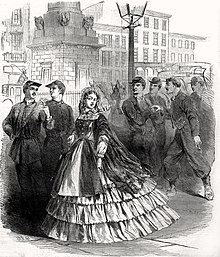
I. LINK
---------------
History of Jazz Dance
----------------------------------------
II. Book Link
--------------------------
Balll Change Cross
Chasse
Pivot Turn
Question 1
----------------------------------------

I. LINK
---------------
History of Jazz Dance
----------------------------------------
II. Book Link
--------------------------
Minstrel Show
Ybor City was founded as an independent town in 1885 by a group of cigar manufacturers led by Vicente Martinez-Ybor and was annexed by Tampa in 1887. The original population was mostly composed of Cuban and Spanish immigrants who worked in the cigar factories. Italian and Eastern European Jewish
immigrants followed shortly thereafter and established many retail
shops, farms and grocery stores, box factories, print shops, and other
enterprises which catered to the cigar industry and its workers.Theater was also popular with the introduction of Cuban vernacular theater, which also included black-face.
According to dance critic Marshall Stearns, (1968) Robinson's contribution to tap dance is exact and specific. He brought it up on its toes, dancing upright and swinging, adding lightness and presence. His signature routine was the Stair Dance, in which he would tap up and down a set of stairs in a rhythmically complex sequence of steps, a routine that he unsuccessfully attempted to patent.
He is best known today for his dancing with Shirley Temple in a series of films during the 1930s, and for starring in the musical Stormy Weather (1943), loosely based on his own life. He used his popularity to challenge and overcome numerous racial barriers, including becoming:
SAN PASCUAL BAILON (Unknown author)
Question
What are the common characteristics of the dances in the three videos?
---------------------
LINK
Development of Ballroom Dances
Question
What is the relationship between ball dances and ballet masters?
----------------
LINK
Question
Which cultures influenced the contradanza in Cuba?
------------------
Time Table
The Siege of Havana was a successful British siege against Spanish-ruled Havana that lasted from March to August 1762, as part of the Seven Years' War. ... Havana remained under British occupation until February 1763, when it was returned to Spain under the 1763 Treaty of Paris that formally ended the war.
The French Revolution began in May 1789 when the Ancien Régime was abolished in favour of a constitutional monarchy. Its replacement in September 1792 by the First French Republic led to the execution of Louis XVI in January 1793, and an extended period of political turmoil
The Haitian Revolution was a successful insurrection by self-liberated slaves against French colonial rule in Saint-Domingue, now the sovereign state of Haiti. The revolt began on 22 August 1791, and ended in 1804 with the former colony's independence.
Spain realized that they could not keep the United States from talking over the Florida territory so in 1819 Spain agreed to sell Florida to the United States. The Adams-Onis Treaty was approved by Spain and the United States in 1821.
The plantation system developed in the American South as the British colonists arrived in Virginia and divided the land into large areas suitable for farming. Because the economy of the South depended on the cultivation of crops, the need for agricultural labor led to the establishment of slavery.
The transfer of Florida from Spain to the United States in 1821 prompted the migration of thousands of American planters into Middle Florida, the region bounded on the west by the Apalachicola River and on the east by the Suwannee.
Cotton became the major cash crop and large numbers of African slaves
toiled on plantations owned by the planter elite. On the eve of the
Civil War in 1860, enslaved persons made up more than half of Middle
Florida's population.

Cover illustration of Harper's Weekly, September 7, 1861 showing a Southern belle.
The image of a Southern belle is often characterized by fashion elements such as a hoop skirt, a corset, pantalettes, a wide-brimmed, straw hat, and gloves. As signs of tanning were considered working-class and unfashionable during this era, parasols and fans are also often represented.
Southern belles were expected to marry respectable young men, and become ladies of society dedicated to the family and community. The Southern belle archetype is characterized by Southern hospitality, a cultivation of beauty, and a flirtatious yet chaste demeanor.Question
Based on the above timeline, what was the relationship between slavery, the southern bell and dance in the South?
Cecilia Valdes is arguably the most important novel of 19th century Cuba. Originally published in New York City in 1882, Cirilo Villaverde's novel has fascinated readers inside and outside Cuba since the late 19th century. In this new English translation, a vast landscape emerges of the moral, political, and sexual depravity caused by slavery and colonialism. Set in the Havana of the 1830s,
French Revolution
Question
What led the French to revolt and let heads roll?
---------------------------------------
LINK
Question
What are the three categories in which ballet dancers are divided for classical repertory?
----------------------
Questions
How did the Russian Ballet school influenced American ballet?
----------------------
La Fille mal gardée (English: The Wayward Daughter, literal translation: "The Poorly Guarded Girl" and also known as The Girl Who Needed Watching) is one of the oldest and most important works in the modern ballet repertory, having been kept alive throughout its long performance history by way of many revivals. The ballet was premiered on 1 July 1789 in Bordeaux, France. The work has undergone many changes of title and has had no fewer than six scores, some of which were adaptations of older music.
Neo-Classical
Contemporary
What is you impression of Havana's carnival in 1961?
3. What do you think about the concept of socio-cultural density posed by Benitez Rojo?
LINK
Society of the Spectacle by Guy Deborg
Question
According to Deborg, what makes the spectacular society vulnerable?
Activity
Students will learn the mains steps of the comparsa (carnival street dance)
Students create their own steps or phrase with 8 moves